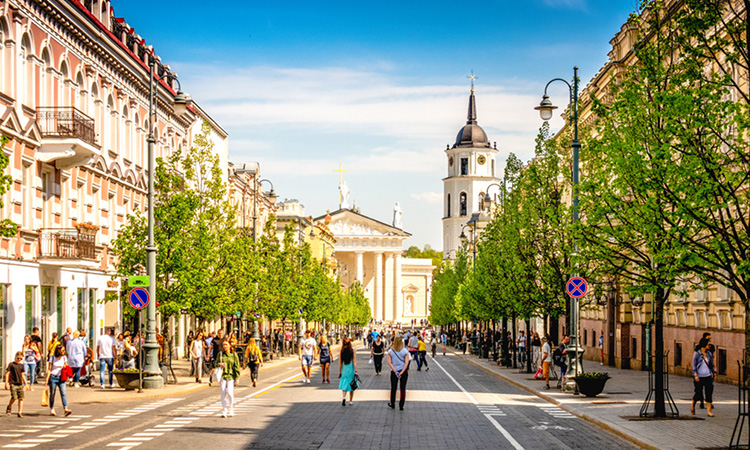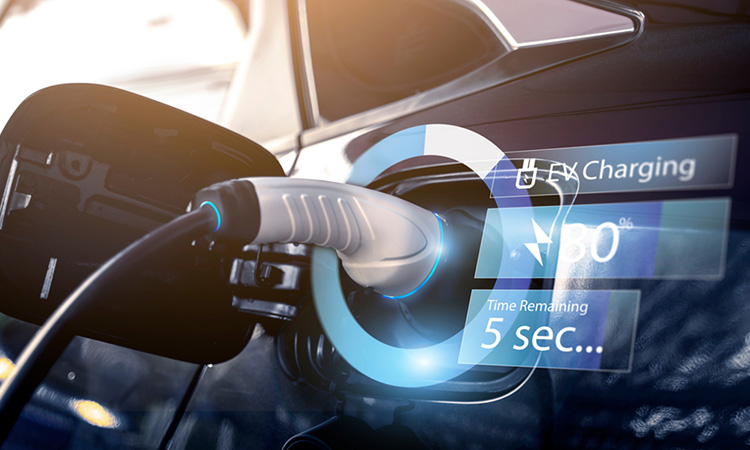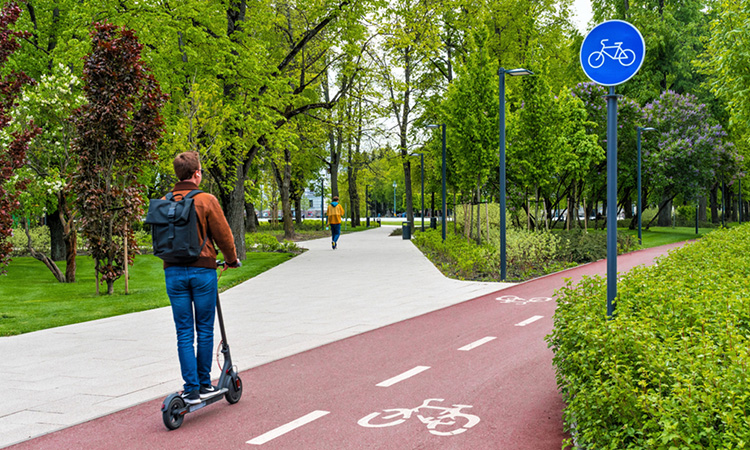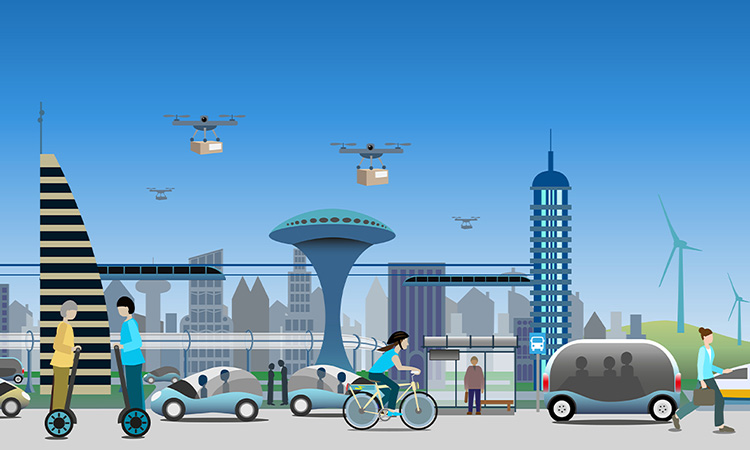Lithuania’s roadmap to a greener transport landscape
- Like
- Digg
- Del
- Tumblr
- VKontakte
- Buffer
- Love This
- Odnoklassniki
- Meneame
- Blogger
- Amazon
- Yahoo Mail
- Gmail
- AOL
- Newsvine
- HackerNews
- Evernote
- MySpace
- Mail.ru
- Viadeo
- Line
- Comments
- Yummly
- SMS
- Viber
- Telegram
- Subscribe
- Skype
- Facebook Messenger
- Kakao
- LiveJournal
- Yammer
- Edgar
- Fintel
- Mix
- Instapaper
- Copy Link
Posted: 19 December 2023 | Agnė Vaiciukevičiūtė - Government of Lithuania | No comments yet
Agnė Vaiciukevičiūtė, Lithuania’s Deputy Minister of Transport and Communications, spoke with Intelligent Transport’s Halimah Haque, about the country’s ambitious journey towards sustainable mobility and the challenges faced in transitioning to greener transportation.


As the Deputy Minister of Transport and Communications, what are your top priorities in promoting sustainable mobility in Lithuania?
Lithuania is at the very beginning of this huge transition, and for the last two years we have been preparing our policies and our investment plans, towards this [modal] shift”
Naturally, we have many priorities and sometimes it’s challenging, because there’s huge targets from European countries to reach by 2030, 2035 and 2040. We’ve seen a lot of change since 2019 when we came into government. We saw that it was the right time to shift investments towards green mobility. Lithuania is at the very beginning of this huge transition, and for the last two years we have been preparing our policies and our investment plans, towards this shift. We are already on the path to reach those ambitious targets, but of course, the road is very bumpy and challenging.
I would say that priorities for us are the same as for most other countries. So, it’s to build infrastructure, which is necessary if we want to move faster, because the market is ready, but we still need to support it. In addition, we are looking to bigger cities, specifically when addressing how we can control pollution levels and the volume of private cars. Even with all the changes we are making, and the solutions we aim to offer, such as micro-mobility and smart mobility, we see that the number of cars is still growing. This is the main challenge which we are now targeting with new infrastructure for electric cars, but at the same time looking into public transport and trying to figure out how to lower the need for personal cars.
How can the Government of Lithuania encourage the adoption of electric vehicles and other alternative fuel vehicles to reduce emissions and promote sustainable transportation?
We are a small country of 2.8 million citizens, and we have 1.6 million cars… Hence, we are facing a huge challenge in bringing about behavioural change, and that is why we are just at the very beginning of this modal shift”
Encouraging the adoption of electric and alternative fuel vehicles is a huge challenge for us in Lithuania, even in these early stages where we are trying to figure out the best ways to move towards a greener transport system. We are a small country of 2.8 million citizens, and we have 1.6 million cars. You can see from those figures that the car is something very special for a Lithuanian person. Hence, we are facing a huge challenge in bringing about behavioural change, and that is why we are just at the very beginning of this modal shift.
It is important to highlight that this transition will be for the next 10 to 20 years, so we will not see the results fast. It will take time. However, we have spent the last two years preparing, investing into infrastructure, into public transport, and the investments are the highest historically that our country has ever seen. We can already see the origins of modal shift, because there is pressure from the market, from society, to achieve our climate goals.
The number of electric cars is growing, helped by the government subsidising the prices of new electric cars for a short period of time, just to gain momentum. Subsidies for the cars and building of new infrastructure are the key elements against a backdrop of careful planning and sub-target goals for 2025, then target goals for 2030.
We are at the very beginning, but we hope that the combination of smart solutions, with the potential of 5G connectivity, can help us succeed. What I really don’t want to see, is a move from combustion pollution to electric pollution. There is a need of much more sophisticated solutions altogether to change the future of transport systems.
When people are choosing their transport mode, even if they’re environmentally conscious, I think that the most important part is still, how efficient the transport mode is. Is it clean? Is it fast? Is it the most comfortable option? Is it cheap? The main focus should be on creating an alternative which you cannot resist.


What initiatives or programmes are currently in place in Lithuania to improve public transportation and make it more sustainable?
First of all, the future is data driven. We really need to understand how our public transport is moving. We are focusing on creating an open data platform to understand, on a real-time basis, how public transport is moving, to enable us to make better decisions for the future, on an efficiency level.
Within the green transition, we want to connect every citizen, to give every person the possibility of mobility… at present not everyone can commute using public transport across all places”
Vilnius, the capital of Lithuania, is piloting the hydrogen buses project. We are keen to see how our investment into the public sector can aid the change from combustion engines to electric and alternative fuels. We want to stay technologically neutral in this area, as for different transport modes there is different technology, and we certainly shouldn’t limit ourselves.
In addition, we are implementing soft tactics. We are dedicating lanes for buses to make travelling by bus more efficient, fast and comfortable for citizens. Our municipalities are creating more lanes and roads solely for public transport.
For me personally, when we are moving through this huge transition, I always explain that we need to do it right; meaning that we don’t need to only lower emissions, but we need to change our public transport so that it is adapted to the needs of everyone. If people are not able to move very easily, for whatever reason, all public transport should be adapted to respond to this. Within the green transition, we want to connect every citizen, to give every person the possibility of mobility, because unfortunately, at present not everyone can commute using public transport across all places. I feel this is a human right, because if you cannot connect and go easily from one place to another, you cannot have a job, you cannot support yourself and you cannot be an integral part of society. People with disabilities form a huge part of this transition for me, and of the policies that we are creating as well.
In your experience, what are the main challenges in transitioning to sustainable mobility in Lithuania, and how do you plan to address them?
”The main challenge, as I mentioned, is that we have too many cars. Changing those cars into other cars (i.e. petrol cars into electric cars) will not change anything, so we need to re-shape the roads. We need to focus on low emission zones. We need to focus on integrating the “polluter pays” principle into our tax system while simultaneously navigating the complex task of finding a political equilibrium between these factors.
It’s important that we are in constant communication with the people. We need to explain our measures so that everybody is on the same page, because if society will not accept the change, it will not work”
In the composition of our society, not everybody can afford new cars or even lower emission cars. This is quite challenging, and this is where our government is taking action with subsidies and creating possibilities to use public transport. I expect that we will have lower emission zones from 2025. I’m sure that there will be some resistance. It’s important that we are in constant communication with the people. We need to explain our measures so that everybody is on the same page, because if society will not accept the change, it will not work.
There should be a good balance of regulations and financial incentives to move to this shift. We are seeing a shift in the younger generation, especially in bigger cities, not only in Lithuania, but everywhere. Now, owning their own car is not a priority, and they’re conscious of using more sustainable travel options.
There is no one thing that fits for all. This is a complex question and the answer is equally complex. You need urban mobility plans, you need investments into public transport, you need to lower the necessity of private cars. You need to create Mobility-as-a-Service (MaaS), and thus more options within cities. It takes time, but as we can see within the MOVE conference, there are a lot of options which could be used to help us connect a data-driven society with smart mobility solutions, and to create better options on different transport modes.


You briefly mentioned modal shift, but are there any specific policies or incentives being implemented to encourage active modes of transportation, such as cycling and walking in Lithuania? And how are these initiatives being received by the public?
With the infrastructure in place in the right way, you see people choosing to cycle because it’s more healthy and sustainable, and if you care for the environment, it’s an obvious choice”
In the last few years, we had an initiative in Lithuania where after destroying an old polluting personal car, it was possible to receive compensation of up to €1000, which can be used to purchase a bicycle or other micro-mobility vehicle. In the last calendar year alone, almost 10,000 applications for the destruction of an old car and an application for the purchase of clean transport were received. However, this initiative ended this June and at this point, we do not have many financial incentives to encourage people to ride bicycles.
But where we are focusing right now in our municipalities, especially the bigger ones, is building the infrastructure needed for bicycles within the cities. Significantly, with the purpose not solely for leisure, but with bicycles being used to go to the shop, to go to a medical institution, to go to university, and so on. We are seeing a shift in attitudes from municipalities, from mayors, towards a better understanding that cycling could be a travel solution in peoples’ everyday lives, to carry out daily tasks and trips, rather than just for recreation. We also need to debunk those theories that weather is a huge factor as to why people are not using bicycles. How then can you explain Norway’s success stories where it’s so often windy, or cold? With the infrastructure in place in the right way, you see people choosing to cycle because it’s more healthy and sustainable, and if you care for the environment, it’s an obvious choice.
At this stage, we’re focusing on creating that infrastructure, and the next step will be implementing initiatives. We want to include businesses, especially bigger corporations, and are considering how to create a system where people who use those micro-mobility options would get benefits or advantages for using this sustainable way of getting to work.
What role can citizens and communities play in promoting sustainable mobility practices?
Our communities and citizens are the main actors in shaping sustainability mobility practices”
I think that our communities and citizens are the main actors in shaping sustainability mobility practices. You can have very good ideas, but if society is not ready or does not understand, their potential can never be realised in full.
We are fortunate to have a very active cyclist society in Lithuania. I feel it is really important to involve them in the policies, to gain their understanding on what we are trying to do here in Lithuania. History says that if we are on the same page, then they become ambassadors of the ideas that we promote.
Having recently become a councillor of the municipality of Vilnius, I’m aware of how communities are very active in different areas. We try, even on a municipality level, to really involve them in the process. Their role in accepting solutions is very important. Naturally, some solutions which need to be made will not gain full consensus, but all play a part in reaching our overarching goals.


As we look to the future, what are your long-term goals and aspirations for sustainable mobility in Lithuania, and how do you plan to achieve them?
The ultimate goal is to have a balanced modal split, where the majority of short distance trips are made using micro-mobility solutions, public transport or just walking, and cars only when it’s necessary”
On a national level, I’m responsible for everything that’s happening related with connectivity, and I think that this is the backbone of all smart mobility. I really believe in artificial intelligence (AI) solutions and that dense connectivity within our cities can create a lot of solutions which will re-shape the environments that we live in.
The ultimate goal is to have a balanced modal split, where the majority of short distance trips are made using micro-mobility solutions, public transport or just walking, and cars only when it’s necessary, for longer distances. That certainly is not to say that we are against cars. From the transport perspective, we see this transition as an opportunity. We are always drawing possibilities and creating more. I think that the future is bright, but it will take time.
With advancements in technology and evolving transportation trends, what emerging solutions or strategies do you foresee playing a significant role in the sustainable mobility landscape of Lithuania in the coming years?
The future is data driven, smart mobility solutions and the cities that dedicate time to innovate will definitely win in the short- and long-term”
That’s a good question. Well, I think that micro-mobility is growing exponentially, which is fantastic, but equally creates a lot of challenges because the infrastructure is not yet there. Currently, there are a lot of areas where you use the same infrastructure for different micro-mobility solutions, which at a certain time doesn’t work anymore because they’re no longer safe. For the near future, the challenge is how to regulate it in a way that people would still be able to use it. This is a top problem at the moment within bigger cities.
Some of the regulations, for example in Vilnius, can really help in creating the right spots for scooters, lowering the speed in certain areas, or forbidding scooters in certain areas completely, to leave only pedestrian streets in the old town. I think this will really help to balance micro-mobility in the cities.
But what I really believe is that the future is data driven, smart mobility solutions and the cities that dedicate time to innovate will definitely win in the short- and long-term.


Related topics
Active travel, Air Quality, Alternative Power, Micro-mobility, Mobility Services, Modal shift, Passenger Experience, Public Transport, Sustainable Urban Transport
Issue
Issue 3 2023
Related modes
Bikes & Scooters, Bus & Coach
Related cities
Vilnius
Related countries
Lithuania
Related organisations
Government of Lithuania
Related people
Agnė Vaiciukevičiūtė







